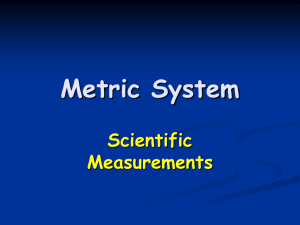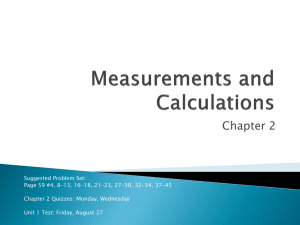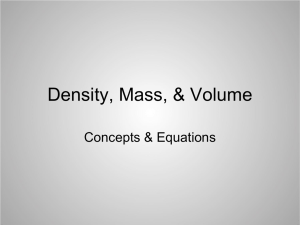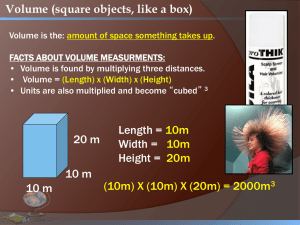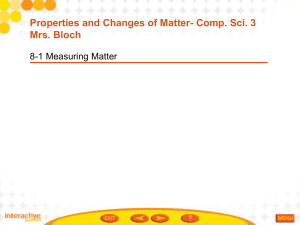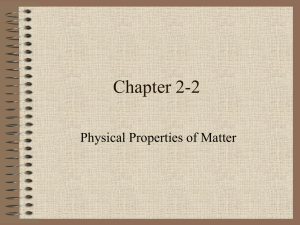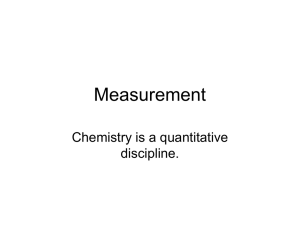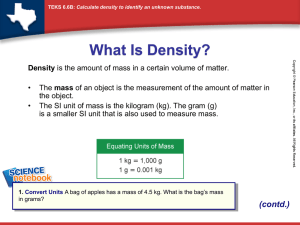Mass
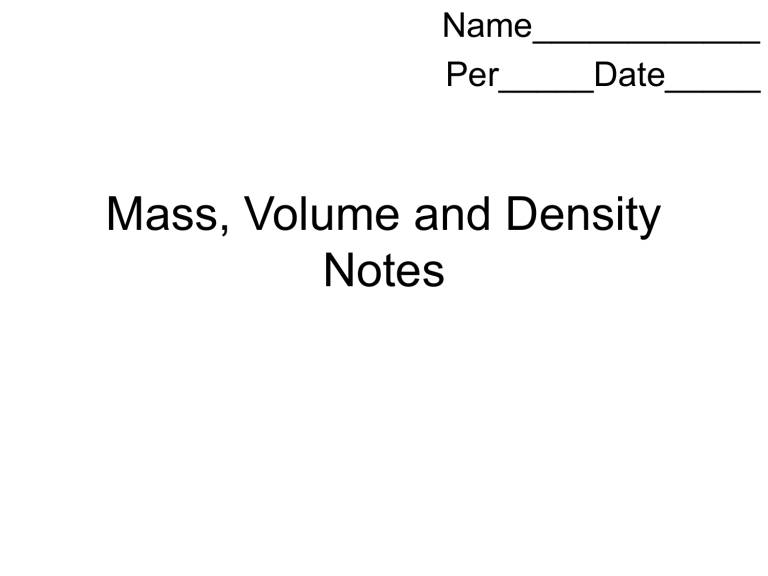
Name____________
Per_____Date_____
Mass, Volume and Density
Notes
Metric System
• Developed by the French in the late 1700’s.
• Based on powers of ten, so it is very easy to use.
• Used by almost every country in the world, with the notable exception of the USA.
• Especially used by scientists.
• Abbreviated SI, which is French for Systeme
International.
Mass
• Mass is the amount of matter that makes up an object.
• A golf ball and a ping pong ball are the same size, but the golf ball has a lot more matter in it. So the golf ball will have more mass.
• The SI unit for mass is the gram.
• A paper clip has a mass of about one gram.
• The mass of an object will not change unless we add or subtract matter from it.
Measuring Mass
• We will use a triple beam balance and a digital top-loading scale to measure mass
.
Weight and Mass
Earth
1 gravity
Jill’s mass
30kg
Jill’s weight
300N
Moon
1/6 th gravity
30kg
50N
Jupiter
2.5 gravities
30kg
On orbit
0 gravity
30kg
750N 0 newtons
Notice that Jill’s mass never changes. Jill is 30kg of little girl no matter where she goes!
Volume
• Volume is the amount of space an object consumes.
• The base unit for volume is the liter.
• There are two methods for finding volume.
Volume of Regular Objects
• We can find the volume of box shapes with the formula Volume = length x width x height.
• In this case the units would be cubic centimeters
(cm 3 ).
• So a box 2 cm x 3 cm x 5cm would have a volume of
30 cm 3
3 cm
Volume of Irregular Objects
We measure volume of irregular objects with a graduated cylinder.
This method is called water displacement
Liquids form a curved surface in graduated cylinders.
Take your reading at the low point of the curve or meniscus
Water Displacement
• Pour 7 ml of water in a graduated cylinder. If a rock causes the level to rise to 9 ml, the rock must have a volume of 2 ml.
Liquid Volume
• 1 cm 3 = 1 ml
•
1 cm 3 of water = 1 ml of water = 1 gram of water
Water Mass and Volume
• 50 ml (50cm 3) of water would have a mass of 50 grams
• 1 Liter of water would have a mass of
_______?
•1 L = 1000 mL so its mass would be 1000 grams or a kilogram.
Density
• Density is the amount of matter (mass) compared to the amount of space (volume) the object occupies .
Density
• Density = mass/volume
• Remember, all fractions are division problems.
• Since the unit for mass is grams, and the unit for volume is ml or cm 3 , then the unit for density is g/ml, or g/ cm 3
Density Formula Wheel
• Formula wheels make it easy to solve density problems.
• Cover the property you are trying to find, and do what is left over.
• To find density, cover the word density. You have mass over volume remaining. So divide mass by volume to find density!
Mass
Density Volume
Understanding Density
• In the following illustration, each square will represent
1 cm3.
• Each g will represent
1 gram.
• Mass = 24g
• Volume = 8 cm3
• Density = ?g/cm3 g g g g g g g g g g g g g g g g g g g g g g g g


